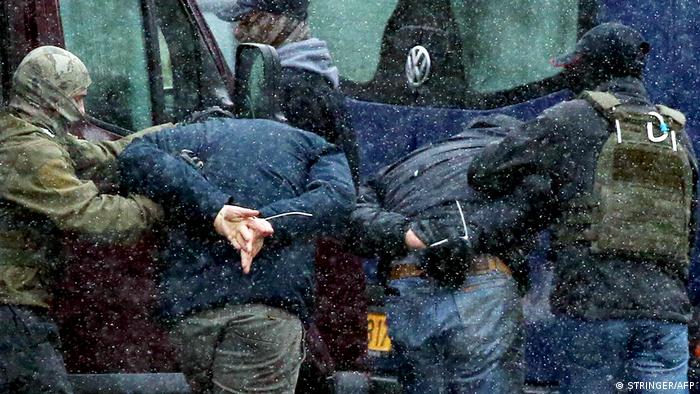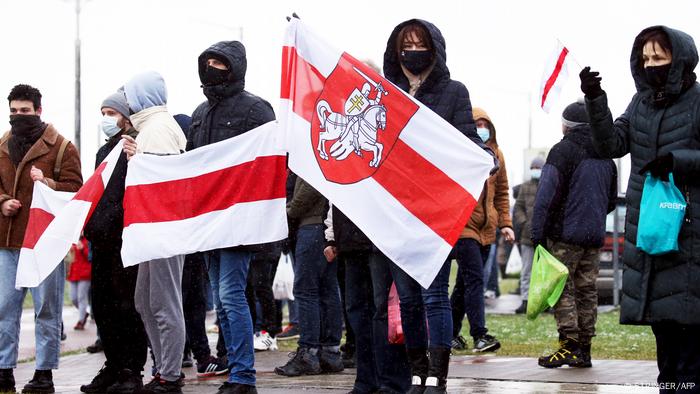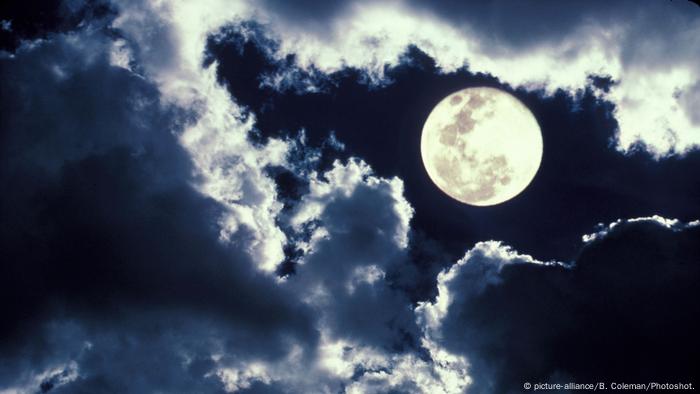Belarus protesters gather in Minsk districts, hundreds arrested
At least 300 people were detained as thousands of opposition protesters staged a series of smaller rallies in Minsk suburbs. Demonstrators had tried a new approach to try to evade a crackdown by authorities.

Belarusian authorities have arrested more than 300 people taking part in anti-government protests in Minsk and other cities.
Massive demonstrations against President Alexander Lukashenko have rocked Belarus since August, when the strongman leader claimed victory in widely disputed polls.
For weeks, security forces have sought to quash the opposition movement by detaining protesters and preventing them from gathering in central Minsk, where the biggest rallies — sometimes attracting hundreds of thousands of people — have taken place.
On Sunday, the opposition appealed to its supporters to instead attend smaller gatherings in different districts of the capital.
Local media reported that at least 20 protests took place in Minsk. In some areas, separate rallies merged to form columns of several hundred people.

Opposition supporters holding former white-red-white flags of Belarus
Heavy security
Riot police were deployed to break up the protests and, as in previous weeks, authorities shut metro stations and blocked mobile phone coverage in an attempt to stop people from meeting. There were also reports of power cuts in some neighborhoods.
"Large columns of people have assembled in all districts of Minsk, without exception. The Lukashenko police are desperately rushing from district to district," said opposition Telegram channel Nexta Live, which has been coordinating the demonstrations.
Read more: Journalism in Belarus: 'Like walking through a minefield'
Belarusian news website Tut.by reported that police were using stun grenades and tear gas, while videos of masked officers dragging protesters into vans circulated on social media.
Human rights group Viasna said that more than 300 people had been taken into custody, most of them in Minsk.
Protesting doctors arrested amid pandemic
'Proud, brave and peaceful'
Western governments have condemned the recent elections as neither free nor fair. Earlier this month, the EU approved new sanctions on Belarusian officials, including Lukashenko, over poll irregularities and the crackdown on protesters.
Belarus' opposition has alleged the election was rigged and that Lukashenko's main challenger, Sviatlana Tsikhanouskaya, who is in exile in Lithuania, was the true winner.
Read more: Will German companies stop cooperating with Belarus?
"Everyone takes to the streets in their district and sees dozens, hundreds and thousands of supporters," Tikhanovskaya said in a message to her Telegram channel ahead of Sunday's protests.
Belarusians are a "proud, brave and peaceful people that have learned the price of freedom and will never agree to live without it," she added.
Lukashenko, an ally of Russia, has refused to resign and has instead offered to reform the constitution.
At least 300 people were detained as thousands of opposition protesters staged a series of smaller rallies in Minsk suburbs. Demonstrators had tried a new approach to try to evade a crackdown by authorities.

Belarusian authorities have arrested more than 300 people taking part in anti-government protests in Minsk and other cities.
Massive demonstrations against President Alexander Lukashenko have rocked Belarus since August, when the strongman leader claimed victory in widely disputed polls.
For weeks, security forces have sought to quash the opposition movement by detaining protesters and preventing them from gathering in central Minsk, where the biggest rallies — sometimes attracting hundreds of thousands of people — have taken place.
On Sunday, the opposition appealed to its supporters to instead attend smaller gatherings in different districts of the capital.
Local media reported that at least 20 protests took place in Minsk. In some areas, separate rallies merged to form columns of several hundred people.

Opposition supporters holding former white-red-white flags of Belarus
Heavy security
Riot police were deployed to break up the protests and, as in previous weeks, authorities shut metro stations and blocked mobile phone coverage in an attempt to stop people from meeting. There were also reports of power cuts in some neighborhoods.
"Large columns of people have assembled in all districts of Minsk, without exception. The Lukashenko police are desperately rushing from district to district," said opposition Telegram channel Nexta Live, which has been coordinating the demonstrations.
Read more: Journalism in Belarus: 'Like walking through a minefield'
Belarusian news website Tut.by reported that police were using stun grenades and tear gas, while videos of masked officers dragging protesters into vans circulated on social media.
Human rights group Viasna said that more than 300 people had been taken into custody, most of them in Minsk.
Protesting doctors arrested amid pandemic
'Proud, brave and peaceful'
Western governments have condemned the recent elections as neither free nor fair. Earlier this month, the EU approved new sanctions on Belarusian officials, including Lukashenko, over poll irregularities and the crackdown on protesters.
Belarus' opposition has alleged the election was rigged and that Lukashenko's main challenger, Sviatlana Tsikhanouskaya, who is in exile in Lithuania, was the true winner.
Read more: Will German companies stop cooperating with Belarus?
"Everyone takes to the streets in their district and sees dozens, hundreds and thousands of supporters," Tikhanovskaya said in a message to her Telegram channel ahead of Sunday's protests.
Belarusians are a "proud, brave and peaceful people that have learned the price of freedom and will never agree to live without it," she added.
Lukashenko, an ally of Russia, has refused to resign and has instead offered to reform the constitution.

Belarus protesters take to the streets with new tactic
Since an August election, Belarus has been gripped by massive protests that erupted after Lukashenko, 66, secured a sixth term as president of the ex-Soviet republic
Sun, November 29, 2020, 4:53 AM MST
Opposition protesters in Belarus took to the streets of the capital Minsk on Sunday in the latest of three months of demonstrations against the re-election of strongman president Alexander Lukashenko.
Since an August election, Belarus has been gripped by massive protests that erupted after Lukashenko, 66, secured a sixth term as president of the ex-Soviet republic.
The opposition believes the election was rigged and political novice Svetlana Tikhanovskaya -- who ran against Lukashenko in the place of her jailed husband -- was the true winner of the polls.
In recent weeks, authorities imposed an intense crackdown in which hundreds were detained and protesters were prevented from gathering in central Minsk.
That prompted Lukashenko's opponents to change tactic, calling on supporters to create small gatherings in every district of the capital.
Dmitry Golubev, a 20-year-old student, told AFP that he was rallying for "fair elections, Lukashenko's resignation and the release of political prisoners".
"We are not evil people, not foreign agents..., we are citizens of Belarus, who want peace, calm and respect for human rights in their country," Golubev said, holding a red and white flag -- a symbol of the Belarus opposition.
According to local media, around 20 rallies were recorded on Sunday across the city.
Sun, November 29, 2020, 4:53 AM MST
Opposition protesters in Belarus took to the streets of the capital Minsk on Sunday in the latest of three months of demonstrations against the re-election of strongman president Alexander Lukashenko.
Since an August election, Belarus has been gripped by massive protests that erupted after Lukashenko, 66, secured a sixth term as president of the ex-Soviet republic.
The opposition believes the election was rigged and political novice Svetlana Tikhanovskaya -- who ran against Lukashenko in the place of her jailed husband -- was the true winner of the polls.
In recent weeks, authorities imposed an intense crackdown in which hundreds were detained and protesters were prevented from gathering in central Minsk.
That prompted Lukashenko's opponents to change tactic, calling on supporters to create small gatherings in every district of the capital.
Dmitry Golubev, a 20-year-old student, told AFP that he was rallying for "fair elections, Lukashenko's resignation and the release of political prisoners".
"We are not evil people, not foreign agents..., we are citizens of Belarus, who want peace, calm and respect for human rights in their country," Golubev said, holding a red and white flag -- a symbol of the Belarus opposition.
According to local media, around 20 rallies were recorded on Sunday across the city.

"Large columns of people have assembled in all districts of Minsk, without exception. The Lukashenko police are desperately rushing from district to district," said opposition Telegram channel Nexta Live that has helped coordinate the ongoing demonstrations.
As in previous weeks, several metro stations in the city centre were shut and mobile connection was limited.
Riot police were deployed in large numbers, with the Tut.by news website reporting the use of stun grenades and tear gas.
Minsk police said on Sunday that around 250 people were taken into police custody during the protests in the capital.
"Everyone takes to the streets in their district and sees dozens, hundreds and thousands of supporters," Tikhanovskaya, 38, said in a video address posted on her Telegram channel on Saturday.
She added that Belarusians are a "proud, brave and peaceful people that have learned the price of freedom and will never agree to live without it".
Tikhanovskaya fled to EU member Lithuania shortly after the August vote and has received support from several Western leaders, who refuse to recognise the election results.
The European Union has slapped sanctions on Lukashenko and a number of his allies over election rigging and a violent crackdown on demonstrators.
Belarus police detained thousands of protesters in the first days of the demonstrations, with many reporting torture and abuse in custody.
Lukashenko, who has the firm backing of Moscow, has refused to step down and instead has suggested reforms to the constitution to placate the opposition.










